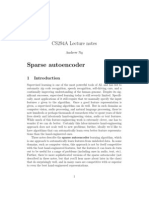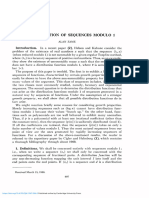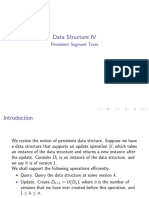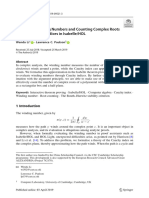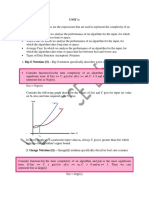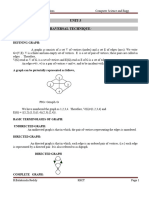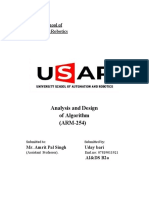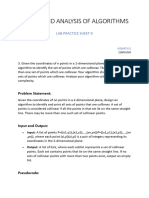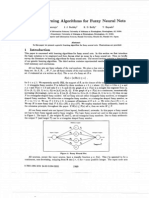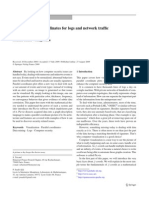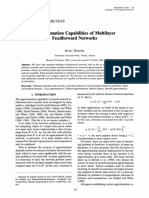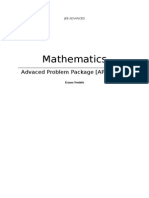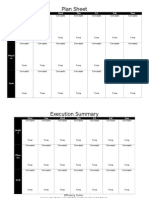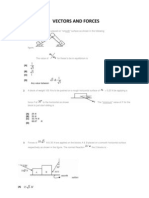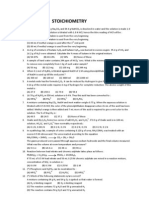0 ratings0% found this document useful (0 votes)
17 viewsProgramming Assignment 7 Looking For Cycles in A Graph Submission Deadline: 11:55PM, Sunday Nov. 16, 2014 Submissions Only Via Moodle
Programming Assignment 7 Looking For Cycles in A Graph Submission Deadline: 11:55PM, Sunday Nov. 16, 2014 Submissions Only Via Moodle
Uploaded by
Sanjana AroraThis document provides instructions for Programming Assignment 7 which involves looking for cycles in a graph represented as an adjacency list. Students are asked to write a function that takes an adjacency list as input and returns all the cycles present in the graph as well as the longest cycle. The input graph will be provided as an (int * int list) list and students must also write a function to validate that the input represents a valid graph. They are advised to use a stack data structure and must thoroughly test and document their programs along with analyzing the time and space complexity.
Copyright:
© All Rights Reserved
Available Formats
Download as PDF, TXT or read online from Scribd
Programming Assignment 7 Looking For Cycles in A Graph Submission Deadline: 11:55PM, Sunday Nov. 16, 2014 Submissions Only Via Moodle
Programming Assignment 7 Looking For Cycles in A Graph Submission Deadline: 11:55PM, Sunday Nov. 16, 2014 Submissions Only Via Moodle
Uploaded by
Sanjana Arora0 ratings0% found this document useful (0 votes)
17 views1 pageThis document provides instructions for Programming Assignment 7 which involves looking for cycles in a graph represented as an adjacency list. Students are asked to write a function that takes an adjacency list as input and returns all the cycles present in the graph as well as the longest cycle. The input graph will be provided as an (int * int list) list and students must also write a function to validate that the input represents a valid graph. They are advised to use a stack data structure and must thoroughly test and document their programs along with analyzing the time and space complexity.
Original Description:
Assignment 7 CS
Original Title
Assign 7
Copyright
© © All Rights Reserved
Available Formats
PDF, TXT or read online from Scribd
Share this document
Did you find this document useful?
Is this content inappropriate?
This document provides instructions for Programming Assignment 7 which involves looking for cycles in a graph represented as an adjacency list. Students are asked to write a function that takes an adjacency list as input and returns all the cycles present in the graph as well as the longest cycle. The input graph will be provided as an (int * int list) list and students must also write a function to validate that the input represents a valid graph. They are advised to use a stack data structure and must thoroughly test and document their programs along with analyzing the time and space complexity.
Copyright:
© All Rights Reserved
Available Formats
Download as PDF, TXT or read online from Scribd
Download as pdf or txt
0 ratings0% found this document useful (0 votes)
17 views1 pageProgramming Assignment 7 Looking For Cycles in A Graph Submission Deadline: 11:55PM, Sunday Nov. 16, 2014 Submissions Only Via Moodle
Programming Assignment 7 Looking For Cycles in A Graph Submission Deadline: 11:55PM, Sunday Nov. 16, 2014 Submissions Only Via Moodle
Uploaded by
Sanjana AroraThis document provides instructions for Programming Assignment 7 which involves looking for cycles in a graph represented as an adjacency list. Students are asked to write a function that takes an adjacency list as input and returns all the cycles present in the graph as well as the longest cycle. The input graph will be provided as an (int * int list) list and students must also write a function to validate that the input represents a valid graph. They are advised to use a stack data structure and must thoroughly test and document their programs along with analyzing the time and space complexity.
Copyright:
© All Rights Reserved
Available Formats
Download as PDF, TXT or read online from Scribd
Download as pdf or txt
You are on page 1of 1
Programming Assignment 7
Looking for Cycles in a Graph
Submission Deadline: 11:55PM, Sunday Nov. 16, 2014
Submissions only via Moodle
An alternative way to represent a graph is as an adjacency list. Assume the
nodes of the graph are numbered from 1 to N . An adjacency list representation
of a graph lists for each node i, the set of immediate neighbouring nodes of node
i, i.e., all those nodes j such that there is an edge between (i, j) in the graph.
A possible way of representing an adjacency list is
type adj_list = (int * (int list)) list;;
This is a list of elements, each of the form (i, [j1 ; . . . ; jk ]) which means that there
are edges from i to each of j1 ... jk .
Depending on the operations, if one wishes to search for a nodes adjacency
list quickly, one may use a structure such as a binary search tree, where finding
a nodes information is quicker.
In this assignment, you will be given as input a directed graph in adjacency
list form, with nodes labeled from 1 to N for some N . The problem is to list
all possible cycles that appear in the graph. In addition, you should find the
longest cycle. Recall that a cycle is a sequence of nodes u0 , u1 , . . . uk such that
all the edges (ui , ui+1 ) exist for 0 i < k and also the edge (uk , u0 ) exists.
The input will be provided as an (int * int list) list. You will need to
write a function validGraph : (int * int list) list -> bool that verifies that the given input is a graph. Note that the node ids in the list l could
be any integers and need not be in the range 1 . . .Length l.
You should use your Stack package (possibly modified). You must document
your programs adequately, and test your program. You should also analyse the
time and space required.
You might also like
- Codigo TunstallDocument5 pagesCodigo TunstallLidia LópezNo ratings yet
- Graphs 1Document17 pagesGraphs 1KARTIKEY GARGNo ratings yet
- Data StructuresDocument15 pagesData Structuresnishanthchandran782No ratings yet
- Sparseautoencoder 2011newDocument19 pagesSparseautoencoder 2011newThanh TriNo ratings yet
- Sparse AutoencoderDocument15 pagesSparse AutoencoderAqsa KiranNo ratings yet
- BstproblemsDocument2 pagesBstproblemsRandom SwagNo ratings yet
- Model A Wide Variety of Phenomena: Graphs Graph AlgorithmsDocument41 pagesModel A Wide Variety of Phenomena: Graphs Graph AlgorithmsThavam MathialakanNo ratings yet
- Mca-4 MC0080 IDocument15 pagesMca-4 MC0080 ISriram ChakrapaniNo ratings yet
- The Distribution of Sequences Modulo 1Document13 pagesThe Distribution of Sequences Modulo 1cannotchooseaname02No ratings yet
- Data Structure IV: Persistent Segment TreesDocument18 pagesData Structure IV: Persistent Segment TreesNhan Nguyen ThanhNo ratings yet
- BSC Sem4 Algorithms Assignment 1 AnsDocument11 pagesBSC Sem4 Algorithms Assignment 1 AnsMukesh KumarNo ratings yet
- Space Filling Curves Versus Random WalksDocument13 pagesSpace Filling Curves Versus Random WalksSICONG GONGNo ratings yet
- Unit D1 - Decision Mathematics: The ExaminationDocument4 pagesUnit D1 - Decision Mathematics: The ExaminationSean Captain HonestlagoNo ratings yet
- Li-Paulson2019 Article EvaluatingWindingNumbersAndCouDocument30 pagesLi-Paulson2019 Article EvaluatingWindingNumbersAndCouavantisng2203No ratings yet
- Minor 1 Solution PDFDocument6 pagesMinor 1 Solution PDFgNo ratings yet
- 10 1109@MCS 2019 2900788Document4 pages10 1109@MCS 2019 2900788marco.encinamNo ratings yet
- DAA Module 4 - NOTESDocument21 pagesDAA Module 4 - NOTESZeha 1No ratings yet
- COL106 Problems PDFDocument10 pagesCOL106 Problems PDFgNo ratings yet
- HPL Brims 96 04Document18 pagesHPL Brims 96 04jeannotkabNo ratings yet
- Derivative Networks Reducedversion - 2022Document14 pagesDerivative Networks Reducedversion - 2022a.frank.liceNo ratings yet
- Unit 1: Asymptotic NotationsDocument24 pagesUnit 1: Asymptotic NotationsPraveenNo ratings yet
- List Mat NUBDocument18 pagesList Mat NUBIsa AhkirasNo ratings yet
- Unit 3Document18 pagesUnit 3Jyo ReddyNo ratings yet
- Basic PRAM Algorithm Design TechniquesDocument13 pagesBasic PRAM Algorithm Design TechniquessandeeproseNo ratings yet
- Artificial Intelligence Lab Manual R20 (2)Document33 pagesArtificial Intelligence Lab Manual R20 (2)22x51a05d6No ratings yet
- Udaydaa1 7Document75 pagesUdaydaa1 7uday bariNo ratings yet
- Unit 4: TreesDocument28 pagesUnit 4: Treeskingsourabh1074No ratings yet
- Task #4: 1 Ghastly CheckpointsDocument4 pagesTask #4: 1 Ghastly Checkpointsarvind muraliNo ratings yet
- AND Operation Using NNDocument53 pagesAND Operation Using NNsd1802No ratings yet
- DSAL-assignment No-7-8-9-10Document25 pagesDSAL-assignment No-7-8-9-10sandhya.sharma7msNo ratings yet
- Lps 9Document13 pagesLps 9Dhrrishith VikalNo ratings yet
- As Needed For Those Other Classes (So If You Get Lucky and Find A Solution in One ofDocument12 pagesAs Needed For Those Other Classes (So If You Get Lucky and Find A Solution in One ofYogendra MishraNo ratings yet
- Data Structures QuestionsDocument6 pagesData Structures Questionsraman.r.bhardwajNo ratings yet
- Genetic Learning Algorithms For Fuzzy Neural Nets: (ZLB (Z) )Document6 pagesGenetic Learning Algorithms For Fuzzy Neural Nets: (ZLB (Z) )Sangeeta InginshettyNo ratings yet
- Answer Key DSADocument24 pagesAnswer Key DSAMathumathiNo ratings yet
- Theorotical Assignment 2 PDFDocument2 pagesTheorotical Assignment 2 PDFMoazzam HussainNo ratings yet
- Multilayer PerceptronsDocument7 pagesMultilayer PerceptronsNicholas ieltsNo ratings yet
- Applied Parallel Coordinates For Logs and Network Traffic Attack AnalysisDocument29 pagesApplied Parallel Coordinates For Logs and Network Traffic Attack AnalysisChaitali BuradNo ratings yet
- C-Function-PointersDocument9 pagesC-Function-PointersSohamNo ratings yet
- 20MCA023 Algorithm AssighnmentDocument13 pages20MCA023 Algorithm AssighnmentPratik KakaniNo ratings yet
- Unit 5Document28 pagesUnit 5Sathyaprakash JayaramanNo ratings yet
- Tutorial 3, Design and Analysis of Algorithms, 2024Document3 pagesTutorial 3, Design and Analysis of Algorithms, 2024abhishek.mishraNo ratings yet
- A Two-Parameter Family of Non-Parametric, Deformed Exponential ManifoldsDocument16 pagesA Two-Parameter Family of Non-Parametric, Deformed Exponential ManifoldsfognitoNo ratings yet
- Homework IIIDocument3 pagesHomework IIISourabh RajNo ratings yet
- EditorialDocument4 pagesEditorialbraagamer82No ratings yet
- CS 218M Tutorial-1: F (N) G (N) 2 2Document1 pageCS 218M Tutorial-1: F (N) G (N) 2 2ashwinagrawal198231No ratings yet
- (1991) Hornik (Neural Netw.)Document7 pages(1991) Hornik (Neural Netw.)MaxNo ratings yet
- Graph Data StructureDocument19 pagesGraph Data Structurefifan91796No ratings yet
- 3 NotesDocument4 pages3 NotesCyrus LiNo ratings yet
- Trilogy Programming Interview QuestionsDocument3 pagesTrilogy Programming Interview QuestionsV JNo ratings yet
- Graph Theory and Path Searches in PythonDocument3 pagesGraph Theory and Path Searches in PythonMuhammad AbubakerNo ratings yet
- Week 5Document5 pagesWeek 5quaned2k5No ratings yet
- Unit Iv Non Linear Data Structures - GraphsDocument29 pagesUnit Iv Non Linear Data Structures - GraphsRekhasreeGoneNo ratings yet
- UPT Cours GTV2Document37 pagesUPT Cours GTV2orjetaNo ratings yet
- Accenture Coding Part 1Document5 pagesAccenture Coding Part 1atishayjainentertainNo ratings yet
- 02b AnalysisDocument19 pages02b Analysisap6487No ratings yet
- Ex 3Document2 pagesEx 3Sanjana AroraNo ratings yet
- Mind MapDocument2 pagesMind MapSanjana AroraNo ratings yet
- Mathematics: Advaced Problem Package (APP/Notes)Document6 pagesMathematics: Advaced Problem Package (APP/Notes)Sanjana AroraNo ratings yet
- Plan Sheet: Mon Tue Wed Thu Fri Sat SunDocument2 pagesPlan Sheet: Mon Tue Wed Thu Fri Sat SunSanjana AroraNo ratings yet
- Vectors and Forces: N & 30 N Are Applied On The Blocks A & B Placed On A Smooth Horizontal SurfaceDocument4 pagesVectors and Forces: N & 30 N Are Applied On The Blocks A & B Placed On A Smooth Horizontal SurfaceSanjana AroraNo ratings yet
- STOICHIOMETRYDocument3 pagesSTOICHIOMETRYSanjana Arora100% (1)



